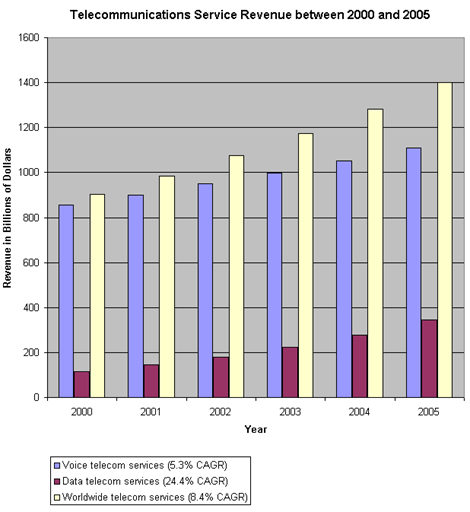IDC: Telco Data Boom Underway
Wireless and data access services are fueling worldwide telecommunications growth, says IDC report
January 30, 2002

As a drop of good news in an economically depressing bucket, IDC released a study last week showing that the worldwide telecommunications service market is still strong and growing.
The report may come as a surprise to many, as numerous service providers struggle with mounting losses, debt, and even bankruptcy (see Qwest Keeps Cutting and Global Crossing Falls Overboard).
But the report may underscore some trends that are already known to be confounding some service providers: It's data services that are experiencing the healthy growth, while traditional long-distance voice services are dragging on profits.
In 2001, the telecom services segment saw its revenues pass the $1 trillion mark for the first time, experiencing a 10 percent hike throughout the year and ending up at $1.1 trillion by year-end, according to IDC.
And the growth doesn’t stop there. IDC predicts that by 2005, the global telecom market will have grown to $1.4 trillion.  The growth, according to IDC, is due to the expansion of access lines around the world, as well as the rapid increase in data networking revenue. To date, the market for voice services, fueled especially by wireless growth, represents 86 percent of the total revenue of the global telecom market. Other segments of the market are, however, catching up.
The growth, according to IDC, is due to the expansion of access lines around the world, as well as the rapid increase in data networking revenue. To date, the market for voice services, fueled especially by wireless growth, represents 86 percent of the total revenue of the global telecom market. Other segments of the market are, however, catching up.
While the market research company expects voice telecom services to see a global compound annual growth rate (CAGR) of 5.3 percent for a forecast period of five years between 2000 and 2005, it predicts that the data service market will increase at a CAGR of 24.4 percent for the same period. During this time, IDC anticipates that voice will have grown from $856 billion to $1,109 billion, while data services will have increased from $116 billion to $347 billion.
“Worldwide data revenue will be driven by the growth of IP-based and wireless data services,” says co-author of the report Rena Bhattacharyya, who is a senior research analyst for IDC’s Worldwide Telecommunications Markets. “These two markets are expected to almost double in size from 2002 to 2005.”
According to the report, the wireless penetration will continue to increase, with especially strong growth rates in developing countries. While an increase in fixed-line penetration in regions of the world with less developed telephone lines is also expected, the wireless growth in these areas will be more important. “It’s often cheaper to install a wireless network than a landline,” says Bhattacharyya.
The report revealed that not only are new modes of telecommunications pushing aside the more traditional parts of the market, but that new geographical areas are also in the midst of taking over the market lead. Latin America is an area with a lot of growth potential, and as early as next year, IDC expects the Asia/Pacific market to have become the largest regional telecom market in the world.
“Not to say that growth isn’t strong in the U.S.,” Bhattacharyya says, “but naturally, growth is going to be slower in more mature markets.”
International long distance is the area of the telecom industry that is expected to be hit the hardest over the next couple of years. This, Bhattacharyya says, is mainly because long-distance prices keep coming down. “Even with more usage, it doesn’t make up for the decline in prices."
Selected evidence from recent telecom earnings bear this out. For example, Qwest Communications International Inc. (NYSE: Q) executives said last week that the company was experiencing strong growth in wireless, DSL, and enterprise Internet services (including dedicated and dial-up Internet access and virtual private network services). Revenue from these services grew 42 percent, 85 percent, and 30 percent, respectively, for the quarter. But despite such growth in data services, Qwest's overall growth rate and profit levels declined.
Another reason long distance is suffering is the growing array of options available to consumers --like wireless phones with no long distance charges. IDC predicts that IP telephony will have the greatest impact on the international long-distance market.
The problems in long distance are bound to cause an overall reduction in revenue in the voice service sector, especially in North America, Europe, and the developed countries of the Asia/Pacific region.
— Eugénie Larson, Reporter, Light Reading
http://www.lightreading.com
You May Also Like










